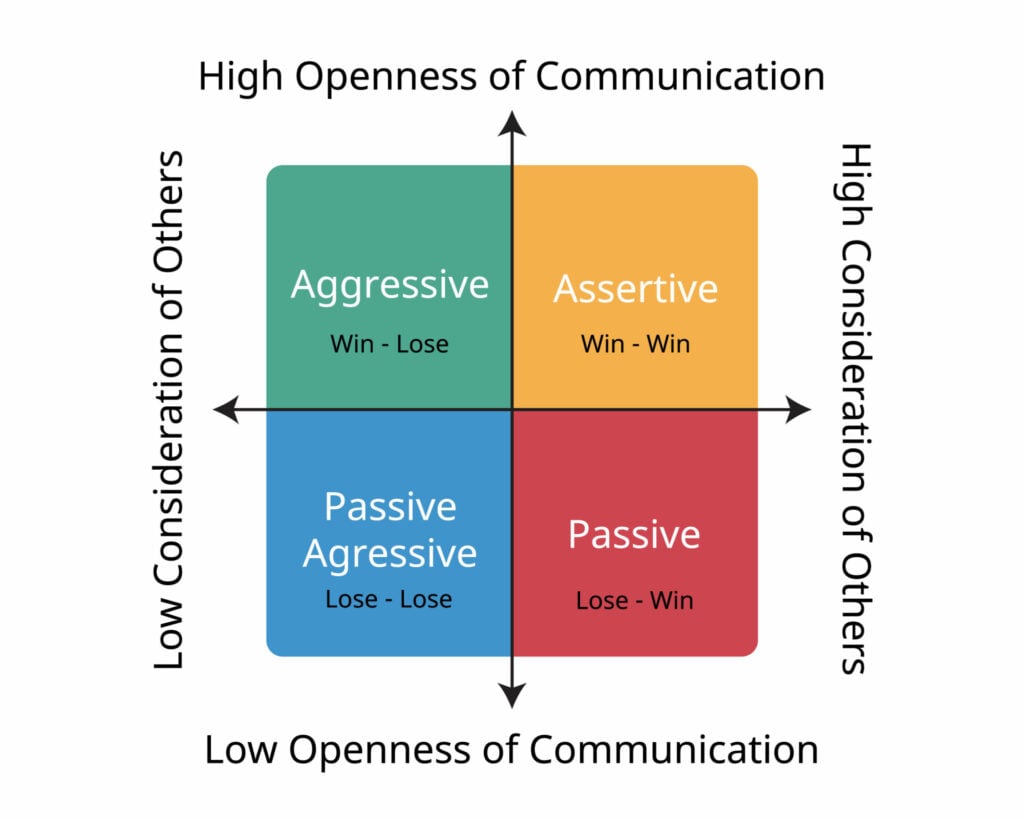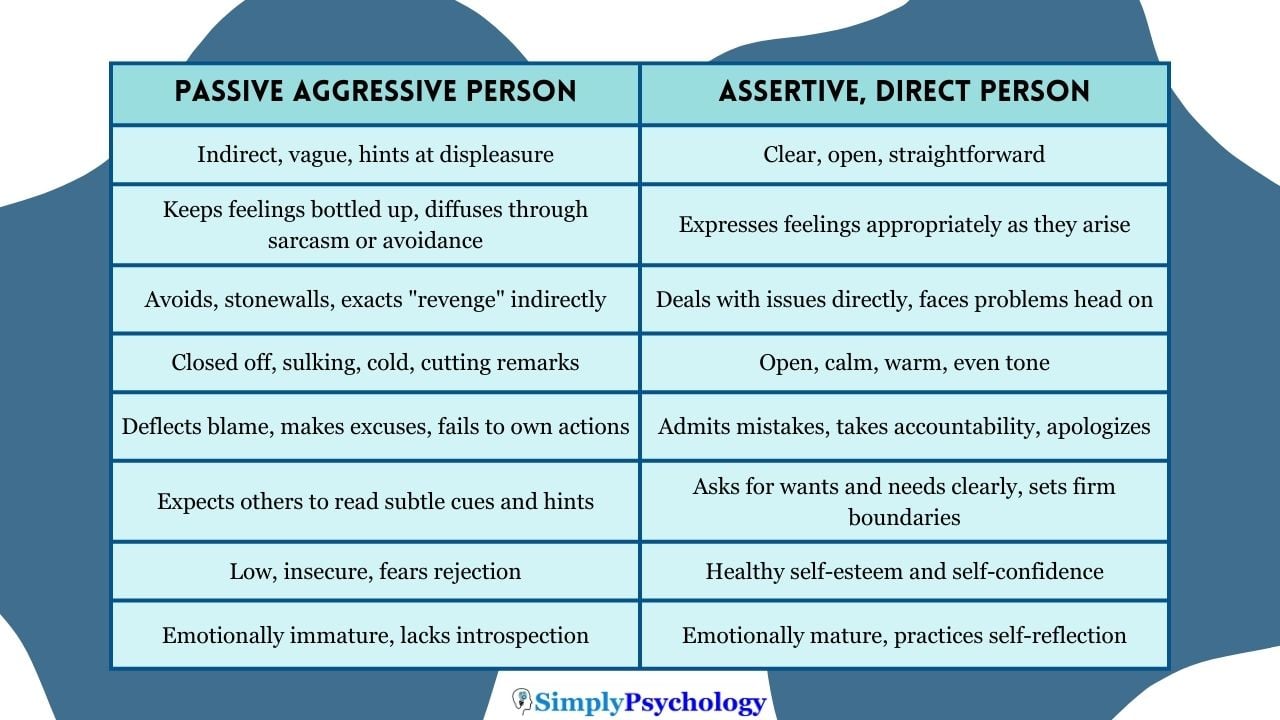It is often easier to recognize passive-aggressive behavior in others, but sometimes, we may use passive aggression without realizing it.
Passive aggressive behavior involves expressing negative feelings in an indirect, subtle, or manipulative way instead of openly communicating them.
Examples include procrastinating on tasks someone has requested you to do, showing up late to events, ignoring someone’s messages, making subtle criticisms or negative remarks disguised as jokes, giving the silent treatment, or intentionally working slowly when someone wants you to hurry.
Passive-aggressive people avoid direct confrontations about their real feelings and use indirect means to convey their dissatisfaction or anger. There are many ways to deal with other people’s passive-aggression.

It’s important to work on your own passive-aggressive behavior because it can damage relationships, create negative environments, and prevent open communication.
Learning healthier communication patterns leads to more authentic connections, self-awareness, and respect between people.
Below are some ways in which you can notice and work on your own passive-aggressive behavior:
Reflect on your behavior
Once you know what passive-aggression is, take a step back and reflect on your own behavior.
You can ask yourself the following questions:
- Do I get moody or sulk when I am unhappy?
- Do I avoid talking about my feelings when I am upset?
- Do I often avoid talking to people if I am annoyed with them?
- Do I delay or stop doing things for others as a way to punish them?
- Do I use sarcasm at times when I should be engaged in meaningful conversation?
- Do I often go along with others’ suggestions but then resent them for it later?
- Do I have a fear of confrontation or setting boundaries with others?
- Do I worry that people will be angry with me if I tell them how I really feel?
“A good way to identify this and to improve on it is to try and catch yourself. So it’s hard to do at the time because you’re feeling annoyance … but then later on when you’ve calmed down a bit you’ve taken a bit of time them out and you feel a bit better it’s good to reflect on how you were with that person why were you a bit short. What was really going on for you?”
Dr Becky Spelman, Counselling Psychologist.
Consider why you may be acting passive-aggressive
It can be useful to consider the reasons why you may be behaving in a passive-aggressive way. Consider the circumstances- do you tend to behave in this way in certain situations, such as at work or with family?
Does it seem to happen more when you are in a situation where you do not feel comfortable expressing your assertiveness?
For example, you may act passive-aggressive around your supervisor at work because you do not feel confident enough to tell them how you truly feel and worry about the consequences of doing so.
Consider whether you recognize these behaviors in people in your life, such as your partner, parents, or friends. It could be that you only act passive-aggressively around other passive-aggressive people.
If you notice that your parents or other family members are also passive-aggressive, consider that this could be why you are also behaving in this way.
John frequently uses passive aggression against his wife Veronica when he is upset with her. Instead of discussing issues openly, John gives Veronica the silent treatment or makes snide comments disguised as jokes. As a child observing this dynamic between his parents, their son Michael picked up on some of these unhealthy communication patterns. For example, when Michael is angry with his girlfriend Emily, he sometimes shuts down emotionally or makes subtle criticisms rather than expressing his true feelings. Michael learned from his father John to avoid direct confrontation about what is bothering him. Recognizing these passive aggressive tendencies that he learned from his father is the first step for Michael to unlearn them. With self-awareness, Michael can start developing more open and assertive communication skills in his relationships.
Are there specific triggers?
Try to identify any triggers or situations that commonly cause these behaviors to emerge.
For some, passive aggression arises in moments of conflict or disagreement with a partner or friend. When faced with potential confrontation, the passive-aggressive response takes over to avoid direct communication.
For others, triggers could be requests to complete undesired tasks:
Whenever Lana's parents ask her to complete household chores, she purposely takes a long time to complete them, putting them off until her parents become frustrated with her. When confronted, she says, 'I was just about to do it!'
Instead of openly declining, procrastination or intentional inefficiency could occur.
Passive aggression can also flare up when someone feels jealous, insecure, or threatened. Their underlying emotions get expressed through indirect sarcasm or withdrawal rather than honesty.
Keeping a log of when passive aggression gets used and any precipitating events can reveal insightful patterns.
Knowing your personal triggers provides opportunities to short-circuit the behavior as it starts and make better choices.
Over time, this builds self-awareness and emotional intelligence to handle difficult situations more constructively rather than resorting to subtle sabotage, avoidance, or manipulation.
Accept how you feel
When you become aware that you are experiencing anger, frustration, or annoyance, accept these emotions rather than suppressing or judging them.
Remember that it is normal to experience challenging feelings; they are part of being human.
Try to own the emotions when they arise rather than pushing them down or ignoring them. Some tips for acceptance:
- Name the emotion you are feeling. Put words to it such as “I notice I am feeling irritated right now.”
- Avoid making it wrong or beating yourself up. Remind yourself all emotions are natural.
- Don’t get wrapped up in the story about why you feel this way. Just acknowledge the sensation.
- Focus on allowing the feeling to exist rather than struggling against it.
- Imagine making space for the emotion to be there rather than pushing it away.
For example, when your friend cancels plans at the last minute, you might notice anger bubbling up. Instead of pretending you’re not bothered, accept that you feel annoyed in the moment.
Let the frustration settle in your mind while acknowledging it’s okay to feel this way. With practice, emotional acceptance becomes easier, making way for better communication and less passive aggression.
Practice assertiveness
The opposite of expressing anger passively is to be more direct with people when something annoys you. This does not mean that you should be mean-spirited or shout at others, but communicate in a way that respectfully expresses your needs.
Clear communication where you set your boundaries can make way for healthier communication and stronger relationships.

It can be difficult to be assertive if you are not used to this way of communicating. Try to take small steps to get used to being more direct with people.
Last week, Jada's friend Marie canceled their plans to meet for dinner at the last minute and Jada responded with "no problem" even though she felt disappointed. This week, Marie tried to reschedule the dinner plans again at the last minute. Jada decided to take a small step to be more assertive: "Marie, I know plans can come up, but I have to be honest - when you cancel our plans, I feel pretty disappointed because I enjoy spending time with you. If we need to reschedule again, I would really appreciate it if you could let me know in advance so I can make other plans instead of clearing my whole day for it." Jada feels nervous to speak up, but it is a milestone. Marie responds understandingly and appreciates the direct feedback. Jada leaves the interaction feeling empowered since she has taken the first step in owning her voice respectfully.
Note that some people may not be comfortable with you being direct with them, but many others will appreciate you being more straightforward with them.
Speak Your Truth with “I” Statements
One of the cornerstones of assertive communication is using “I” statements to take ownership of your perspective without accusing or attacking others. Some tips:
- Start your sentence with “I feel…” or “I need…” to share your emotions and needs.
- Avoid blanket generalizations like “you always” or “you never,” which can sound blaming.
- Focus on your tangible experience, not assumptions about the other’s motivations.
- Be specific about the situation and your reaction to make the feedback more constructive.
- Maintain a calm, measured tone even when expressing frustration or hurt.
- After sharing your experience, you can ask for the other person’s viewpoint non-judgmentally.
For example, instead of saying, “You’re so inconsiderate for staying out late without calling me,” try “I feel worried and upset when I don’t hear from you past midnight because I care about your safety. In the future, could you please give me a quick call or text if you’re going to be out that late?”
Keeping the focus on your genuine thoughts and feelings builds empathy and compassion.
With practice, “I” statements become a natural way to assert your truth while respecting others. This reduces the bottling up of resentment that leads to indirect, passive-aggressive actions.
Dr Marshall Rosenberg’s book ‘Nonviolent Communication: A Language of Life’ provides thorough guidance for expressing your needs in an assertive way without resulting to toxic communication.
Cultivating Assertiveness
Beyond the basic tips for assertive communication like “I statements,” there are some deeper mindset shifts that can help tackle passive aggression at its roots.
- Pick your battles – Reserve assertiveness for issues that truly matter rather than nitpicking small annoyances. This prevents depleting your emotional bandwidth.
- Stand your ground respectfully – Don’t let others convince you that your needs aren’t valid or important. Stick to your boundaries while considering others’ perspectives, too.
- Separate intent from impact – Assume positive intent from others, but don’t minimize if their actions still hurt you, even if unintentionally.
- Value your voice – Your needs and feelings deserve to be voiced, so don’t automatically default to putting others first.
- Allow others’ discomfort – Some may not love your new assertiveness. As long as you communicate with care, you can’t control their reactions.
- See conflict as an opportunity – Views will differ. Assertiveness helps navigate this for win-win resolutions.
With consistent practice, assertiveness evolves from a skill to a way of being. You gain confidence in owning your space while respecting others’. This empowers clearer communication and reduces suppressed resentment.
Own up to your behavior
One of the most direct ways to address passive-aggressive behavior is to own up to it when you catch yourself in the act. Though uncomfortable, apologizing and stating your true feelings requires courage and vulnerability.
Here are some tips:
- As soon as you realize your passive aggression, address it. Don’t let time go by, e.g., “I realize I was being indirect just now when I said I was fine even though I felt irritated.”
- Be specific about your passive-aggressive action and why it wasn’t appropriate.
- Apologize sincerely, without excuses. “I’m sorry for making that sarcastic joke rather than telling you directly I was angry.”
- Share the underlying emotion/need. “I was actually feeling insecure and wanted reassurance.”
- Thank the other person for listening.
- If needed, follow up later with additional discussion when emotions have settled.
For example, you roll your eyes when your partner asks for help with a chore. Right away, you could say, “I’m sorry for the eye roll. I’m feeling overwhelmed and stressed today, and I should have just said that directly instead of reacting that way.”
Be patient
Recognize that it can take a long time to make a positive change in your life. Identifying your own behaviors is a good first step towards change, although altering your behavior patterns can take time.
Try not to give up on self-improvement if you find that you often fall back into passive-aggressive patterns. Spend time reflecting on why this may have happened and use it as a learning opportunity on your journey to being more assertive.
“Give yourself time and grace as you work through this nothing can be achieved overnight don’t get frustrated at yourself if you find yourself reverting back to these behaviors again everything every time you you try something you’re changing you’re getting better and better.”
Dr. Caroline Leaf, Clinical and Cognitive Neuroscientist

References
Kantor, M. (2002). Passive-aggression: A Guide for the Therapist, the Patient, and the Victim. Greenwood Publishing Group.
Leaf, C. (2021, December 2). Podcast 339: How to recognize & respond to passive aggressive behavior in others AND yourself. [Video]. YouTube. https://www.youtube.com/watch?v=rzYm9Ua6LoI&ab_channel=Dr.CarolineLeaf
Spelman, B. (2022, December 7). How to stop being passive-aggressive. [Video]. Youtube. https://www.youtube.com/watch?v=ARPowSVzE4A&ab_channel=Dr.BeckySpelman

